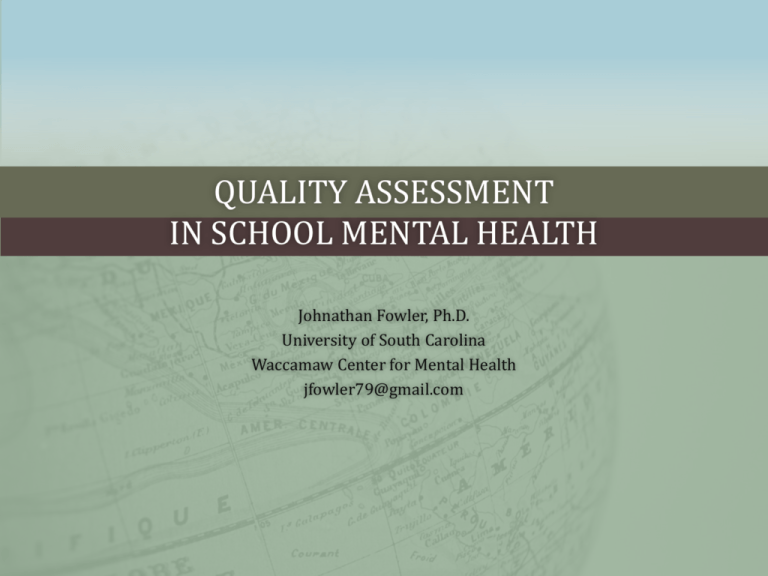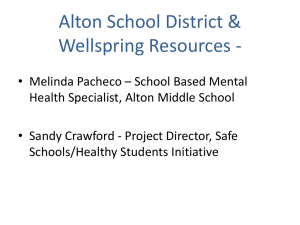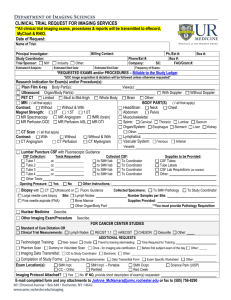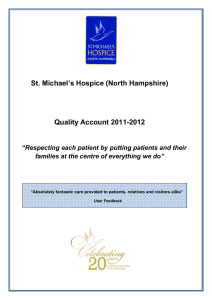Fowler Presentation Carolina Network 1-10-14
advertisement

QUALITY ASSESSMENT IN SCHOOL MENTAL HEALTH Johnathan Fowler, Ph.D. University of South Carolina Waccamaw Center for Mental Health jfowler79@gmail.com HISTORY • NIMH R01 study in Horry County • Two comparison groups: Clinical Services & Support (CSS) and Personal/Staff Wellness (Wellness) • Timetable for next steps EXPANDED SCHOOL MENTAL HEALTH • Many constructs in R01 and SMH in general • Construct for today: Quality Assessment & Intervention – How are we assessing the quality of our work in schools? – What does quality look like? Where do we start? • A starting point: The School Mental Health Quality Assessment Questionnaire (SMHQAQ) – Research-based measure – Developed by the Center for School Mental Health (including leading investigators on the R01) SMHQAQ OVERVIEW • Assesses 40 indicators connected to 10 principles for best practices in SMH. • Team and Individual versions: – Team version as a campus assessment and compass for intervention – Individual version as a reflective and/or summary assessment • R01 experiences – Design and usage – Change in implementation after Year 1 – Pros and cons in practice SMHQAQ OVERVIEW • R01 experiences – Clinician feedback – Senior trainer feedback ACTIVITY • Identify 3+ indicators which you feel may be most salient in the schools you work with • “Road map” activity for use with school-based counselors and related staff • Indicator guides, web resources, etc. 10 PRINCIPLES OF SMH QUALITY Principle Description 1 All youth and families are able to access appropriate care regardless of their ability to pay. (access to care; funding) 2 Programs are implemented to address needs and strengthen assets for students, families, schools, and communities. (needs assessment; addressing needs and strengths) 3 Programs and services focus on reducing barriers to development and learning, are student and family friendly, and are based on evidence of positive impact. (evidence-based practice: screening, assessment, and intervention) 10 PRINCIPLES OF SMH QUALITY Principle Description 4 Students, families, teachers and other important groups are actively involved in the program's development, oversight, evaluation, and continuous improvement. (stakeholder involvement and feedback) 5 Quality assessment and improvement activities continually guide and provide feedback to the program. (quality assessment and improvement) 6 A continuum of care is provided, including school-wide mental health promotion, early intervention, and treatment. (continuum of care; referral process) 10 PRINCIPLES OF SMH QUALITY Principle Description 7 Staff holds to high ethical standards, is committed to children, adolescents, and families, and displays an energetic, flexible, responsive and proactive style in delivering services. (clinician training, support, and service delivery) 8 Staff is respectful of, and competently addresses developmental, cultural, and personal differences among students, families and staff. (competently addressing developmental, cultural, and personal differences) 9 Staff builds and maintains strong relationships with other mental health and health providers and educators in the school, and a theme of interdisciplinary collaboration characterizes all efforts. (interdisciplinary collaboration and communication) 10 Mental health programs in the school are coordinated with related programs in other community settings. (community coordination) INDICATORS OF SMH Principle Description 1 All youth and families are able to access appropriate care regardless of their ability to pay. 1) When indicated, does your school mental health team provide case management assistance to students and families to assist them in obtaining health insurance or to facilitate enrollment in programs for which they are eligible? 2) Is your school mental health team engaged in activities that may bring resources or financial support into the school mental health program? INDICATORS OF SMH Principle Description 2 Programs are implemented to address needs and strengthen assets for students, families, schools, and communities. 3) Has your school mental health team conducted assessments on common risk and stress factors faced by students (e.g., exposure to crime, violence, substance abuse)? 4) Has the school mental health team held meetings with students, parents, and teaching staff to ask them about their needs and to ask them for their recommendations for actions by school mental health staff? 5) Does the school mental health team have services in place to help students contend with common risk and stress factors? 6) Does the school mental health team match provided services to the presenting needs and strengths of students/families after initial assessment? INDICATORS OF SMH Principle Description 3 Programs and services focus on reducing barriers to development and learning, are student and family friendly, and are based on evidence of positive impact. 7) Does your school mental health team receive ongoing training and supervision on effective diagnosis, treatment planning and implementation, and subsequent clinical decision-making? 8) Does your school mental health team conduct screening and follow-up assessments to assist in the identification and appropriate diagnosis of mental health problems? 9) Does your school mental health team continually assess whether ongoing services provided to students are appropriate and helping to address presenting problems? 10) Is there a clear and effective protocol to assist the school mental health team in their clinical decision making and care for more serious situations (e.g., abuse and neglect reports, self-reporting of suicidal/homicidal ideation)? 11) Is your school mental health team actively using the evidence-base (practices and programs) of what works in child and adolescent mental health to guide your preventive and clinical interventions? INDICATORS OF SMH Principle Description 4 Students, families, teachers and other important groups are actively involved in the program's development, oversight, evaluation, and continuous improvement. 12) Has an advisory board (including youth, families, administrators, educators, school health staff, community leaders) been developed for the school mental health programs? 13) Does the school mental health team collaborate closely with school administrators and offer numerous opportunities for recommendations, feedback, and involvement in program development and implementation? 14) Does the school mental health team participate in methods or activities (e.g., meetings, focus groups, surveys) to obtain feedback on an ongoing basis from key stakeholders on how the program is functioning and how it can be improved? 15) Does the school mental health team engage in efforts to ensure that stakeholder ideas and recommendations are actually implemented in a timely manner? 16) Does the school mental health team provide training and educational activities for families, teachers and other stakeholder groups based on their recommendations and feedback? INDICATORS OF SMH Principle Description 5 Quality assessment and improvement activities continually guide and provide feedback to the program. 17) Are your school mental health team’s efforts and activities being guided by an active and effective quality assessment and improvement plan that other school mental health clinicians and stakeholders (school staff, families, community) are aware of? 18) Has the school mental health team been well trained in paperwork requirements for the school mental health program, and do their records clearly reflect delineated policies and procedures? 19) Is the school mental health team ensuring that families are meaningfully involved in treatment planning and ongoing therapy efforts? 20) Are peer review mechanisms in place to receive feedback from other mental health staff on the way the team handles cases and/or implements preventive and clinical interventions? 21) Does the school mental health team actively use an evaluation plan that provides measurable results to and helps to improve preventive and clinical intervention efforts? 22) Does the team share positive and negative findings from the evaluation of services with youth, families, school staff and other stakeholders? INDICATORS OF SMH Principle Description 6 A continuum of care is provided, including school-wide mental health promotion, early intervention, and treatment. 23) Does the school mental health team offer activities promoting school-wide mental health? 24) Is the school mental health team actively involved in developing and implementing training and educational activities for educators on the identification, referral, and behavior management of social/emotional/behavioral problems in students? 25) Does the school mental health team offer group, classroom, and school-wide prevention activities? 26) Does the school mental health team offer intensive treatment services to youth and families including individual, group, and family therapy? 27) Is the team able to continue to have mentoring relationships with students who no longer present serious problems? 28) Are referral procedures being well utilized by educators, the school mental health staff, other mental health staff, health staff, administrators, parents and students? 29) Does the school mental health team promptly screen/assess all students who have been referred for services? INDICATORS OF SMH Principle Description 7 Staff holds to high ethical standards, is committed to children, adolescents, and families, and displays an energetic, flexible, responsive and proactive style in delivering services. 30) Is the school mental health team sufficiently trained, supported, and supervised to handle the unique demands of school-based practice in an ethical and effective manner? 31) Are the services provided by the school mental health team characterized by a flexible, proactive approach that enables youth and families in need to be served as rapidly as possible? INDICATORS OF SMH Principle Description 8 Staff is respectful of, and competently addresses developmental, cultural, and personal differences among students, families and staff. 32) Does the school mental health team receive regular training on effectively providing care for students and families who present diverse developmental, cultural, ethnic, and personal backgrounds? 33) Does the school mental health team’s caseload reflect the diversity of the school population? 34) Does the school mental health team make efforts to ensure that school mental health programs and services are welcoming and respect the students and families served? 35) Are key stakeholders who provide ongoing guidance to your school mental health program diverse in terms of gender, race/ethnicity, and personal/cultural background? INDICATORS OF SMH Principle Description 9 Staff builds and maintains strong relationships with other mental health and health providers and educators in the school, and a theme of interdisciplinary collaboration characterizes all efforts. 36) Does the school mental health team help to coordinate mental health efforts in the school to ensure that youth who need services receive them, while avoiding service duplication? 37) Is the school mental health team using or helping to develop communication mechanisms to ensure that information is appropriately shared and that student and family confidentiality is protected? 38) Does the school mental health team actively collaborate with other professionals in your school (other health/mental health providers, educators, administrators)? INDICATORS OF SMH Principle Description 10 Mental health programs in the school are coordinated with related programs in other community settings. 39) Is the school mental health team knowledgeable about existing mental health and related resources for students in the school and community and is this information readily available in a directory that can be broadly shared within the school? 40) Is the school mental health team working closely with other community health and mental health providers and programs to improve cross-referrals, enhance linkages, and coordinate and expand resources? NEXT STEPS • Purpose of quality assessment within DMH infrastructure • Research agendas • Be proactive! DISCUSSION • SMHQAQ: – Feedback on the tool • R01 Clinicians • Senior trainers • Group discussion – Implementation issues – Bad timing or a sign of a larger problem? – Best practice (team makeup, frequency of meetings, etc.) • General: – QAI for school mental health climate – Expected resistance (how to combat) DISCUSSION • Future Research – Which questions should we be asking to assess and improve SMH quality?









